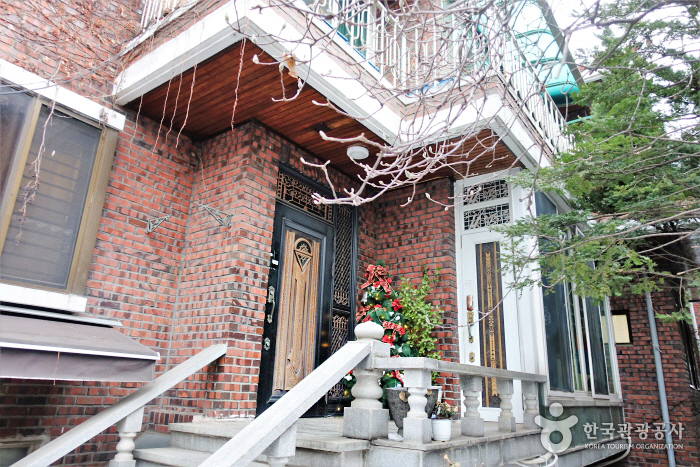Seoul Gyeongdong Market (서울 경동시장)
5.6Km 2024-12-03
3 Gosanja-ro 36-gil, Dongdaemun-gu, Seoul
As the nation began to recover from the aftermath of the Korean War, farmers from the northern Gyeonggi-do region and Ganwon-do gathered around the old Seongdong Station (renamed ‘Hansol Donguibogam’) to sell their produce and wares. The farmers’ impromptu gathering on the fallow farmland to make their transactions soon led to the birth of a new marketplace. With the recent remodeling of the market, including the long-neglected Gyeongdong Theater, the place feels totally renewed and full of energy. Thanks to the renovation and diverse food stalls, the place is always bustling and filled with people.
Starbucks Gyeongdong Market (스타벅스 경동1960)
5.6Km 2024-12-27
3 Gosanja-ro 36-gil, Dongdaemun-gu, Seoul
Restored Gyeongdong Market space and the 5th community store for a win-win relationship with local economy
This 5th Starbucks Community Store is housed in a restored theater in Gyeongdong Market. The store has a win-win agreement with local merchants. Starbucks created a multiple cultural space in collaboration with LG Electronics such as LG Gold Star Radio Refresh Center. Every week, local artists and college students present culture and art performances on the stage that recreated the theatre concept. To offer a special experience suitable to an old theater, Starbucks developed the Retro Theater-like CND. For differentiated customer experiences, the store sells store-baked crafted food and exclusive merchandise.
Olive Young - Geumho Branch [Tax Refund Shop] (올리브영 금호)
5.6Km 2024-04-18
302, Dokseodang-ro, Seongdong-gu, Seoul
-
Apgujeong Yeong Pharmacy - Apgujeong Branch [Tax Refund Shop] (압구정영약국 압구정)
5.6Km 2024-04-18
1F, 25, Apgujeong-ro 28-gil, Gangnam-gu, Seoul
-
Tailor Plastic Surgery [Tax Refund Shop] (테일러성형외과의원)
5.6Km 2024-04-16
#402, 838, Nonhyeon-ro, Gangnam-gu, Seoul
-
Faceline Plastic Surgery (페이스라인 성형외과의원)
5.6Km 2025-10-23
(1st Floor, Wonbang Plaza), 838 Nonhyeon-ro, Gangnam-gu, Seoul
Faceline Plastic Surgery has operated with an accident-free record for 20 years, adhering to the motto "A place where I and my family can safely undergo plastic surgery".
The medical team at Faceline Plastic Surgery includes Dr. Lee Tae-Hee and Dr. Lee Jin-Su, both alumni of Seoul National University College of Medicine, alongside Dr. Lee Shin-Jeong, a graduate of Seoul National University School of Dentistry. They have been working together since the clinic's establishment in Apgujeong in 2005. They regularly present their accumulated clinical experience and expertise at international conferences and have showcased numerous surgical cases through various makeover programs.
Clients of Faceline Plastic Surgery demonstrate unwavering trust over the years, returning for additional procedures. For instance, a client who underwent facial contouring surgery may return for a face lift after 10 years, or a child of a patient who had double jaw surgery might seek similar treatment 20 years later. Similarly, a parent of a patient who had ophthalmoplasty might return for upper blepharoplasty surgery.
In this manner, Faceline Plastic Surgery maintains long-term relationships based on client trust and satisfaction, continuously providing high-quality medical services. The clinic guarantees optimal results based on its extensive experience and skills accumulated over the years.
The House of Yehbon (예본의 집)
5.6Km 2024-08-05
64 , Gaepo-ro 118-gil, Gangnam-gu, Seoul
+82-10-3908-1617
Yebonui House is a detached house, in Gangnam-gu, Seoul, whose first floor is operated as a guest house. The space consists of two rooms plus living room, kitchen facilities, and two bathrooms, and is popular with visiting overseas Koreans and travelers from north America and Europe. Guests will find antique furniture, mother-of-pearl cabinets, and hand-knitted covers, all redolent of Korean history and culture. The Gangnam location makes it super convenient for transport.
Glovi Plastic Surgery (글로비성형외과의원)
5.6Km 2025-10-23
(6th Floor, EGI Building), 843 Nonhyeon-ro, Gangnam-gu, Seoul
"Glovi Plastic Surgery strives to understand the hearts of our clients."
While standards of beauty have varied across eras and individuals, true beauty remains timeless. At Glovi Plastic Surgery, we are dedicated to discovering and delivering enduring beauty by continuously researching and refining our techniques to ensure the highest level of satisfaction for each patient.
With extensive experience and exceptional technical expertise, Glovi Plastic Surgery offers personalized cosmetic surgery programs tailored to individual characteristics. Our dedicated stem cell research lab, certified by the Ministry of Science, ICT and Future Planning as an R&D department, showcases our differentiated technological capabilities. Additionally, we provide customer satisfaction programs that prioritize patient safety and convenience.
Glovi Plastic Surgery's commitment to rewarding your choice with beauty and confidence continues every day.
DM Plastic Surgery (디엠성형외과)
5.6Km 2025-12-09
(2nd Floor), 158 Apgujeong-ro, Gangnam-gu, Seoul
DM Plastic Surgery is a clinic run by a doctor from Yonsei University College of Medicine, the first university in Korea to establish a plastic surgery department.
As a former professor of plastic surgery at Severance Hospital of Yonsei University College of Medicine for 16 years and a board member of the Korean Society of Plastic and Reconstructive Surgeons, the chief director of DM is always striving to be a model in the medical industry. We promise to spare no effort, guided by the tenet of diligence and sincerity, to advance plastic surgery technology in Korea and to fulfill our responsibilities as plastic surgeons.


![The Face Dental [Tax Refund Shop] (더페이스치과의원)](http://tong.visitkorea.or.kr/cms/resource/00/3314200_image2_1.jpg)
![Olive Young - Geumho Branch [Tax Refund Shop] (올리브영 금호)](http://tong.visitkorea.or.kr/cms/resource/65/2878765_image2_1.jpg)
![Apgujeong Yeong Pharmacy - Apgujeong Branch [Tax Refund Shop] (압구정영약국 압구정)](http://tong.visitkorea.or.kr/cms/resource/89/2879689_image2_1.jpg)
![Tailor Plastic Surgery [Tax Refund Shop] (테일러성형외과의원)](http://tong.visitkorea.or.kr/cms/resource/02/2879602_image2_1.jpg)

 English
English
 한국어
한국어 日本語
日本語 中文(简体)
中文(简体) Deutsch
Deutsch Français
Français Español
Español Русский
Русский